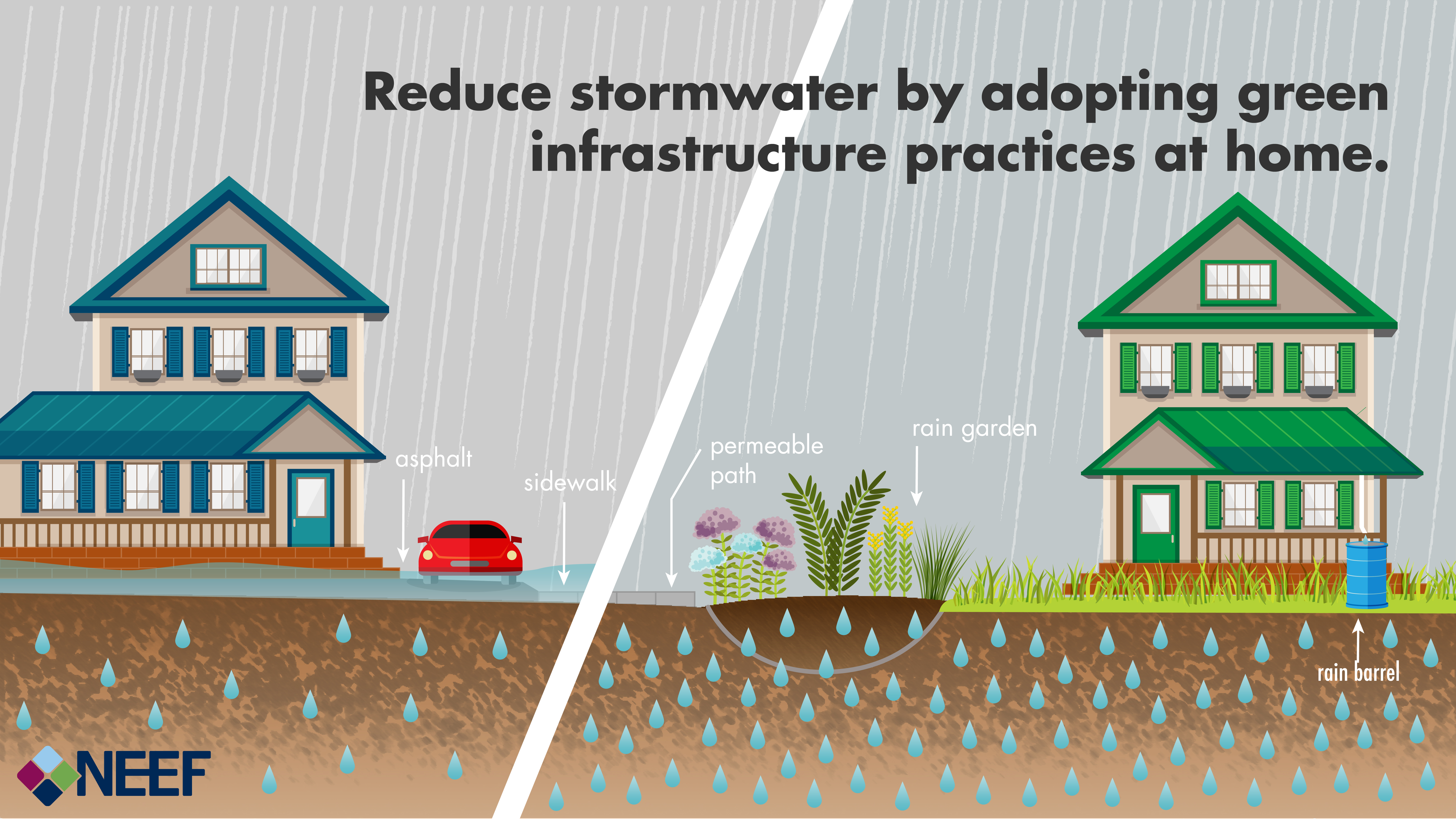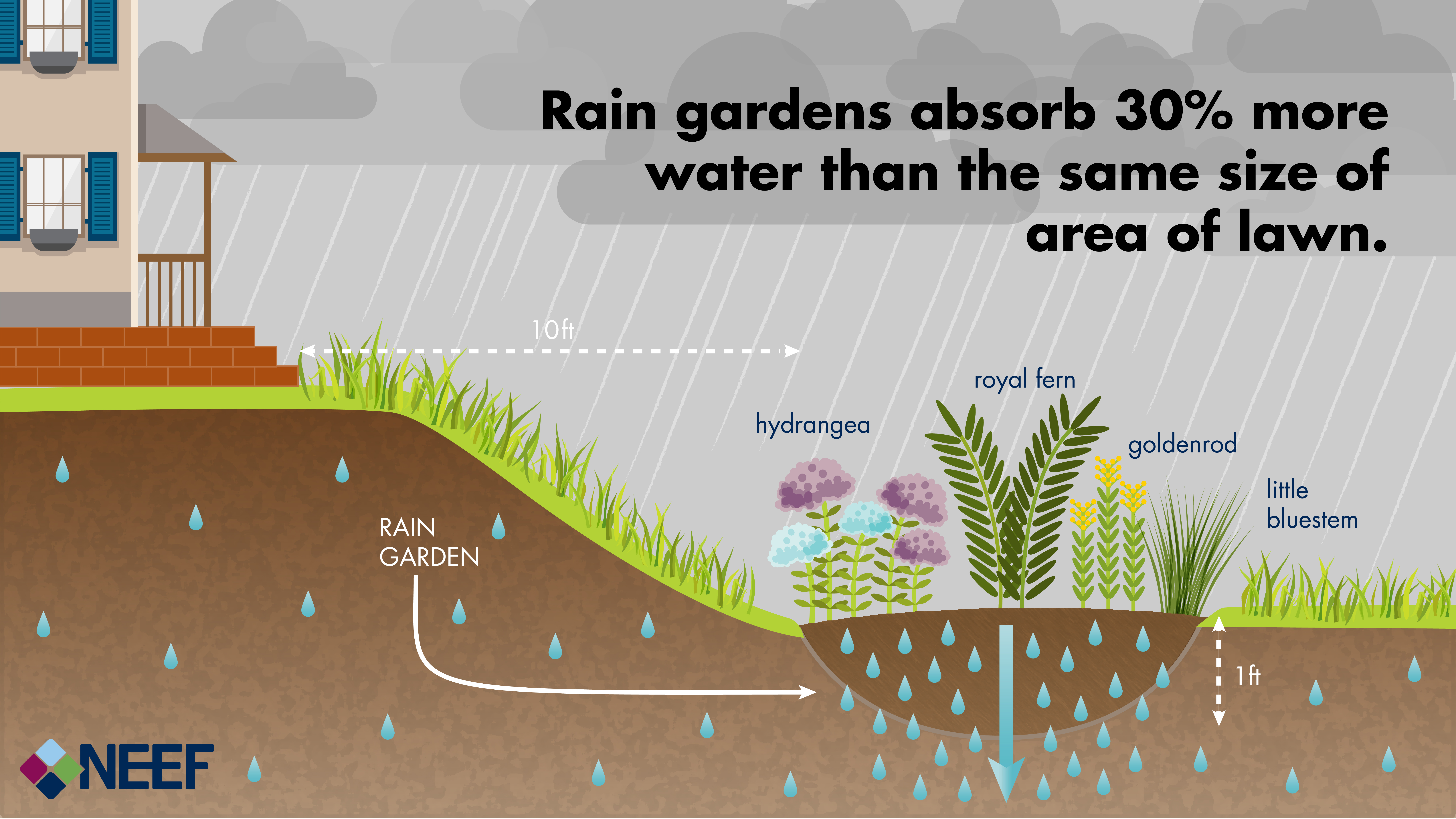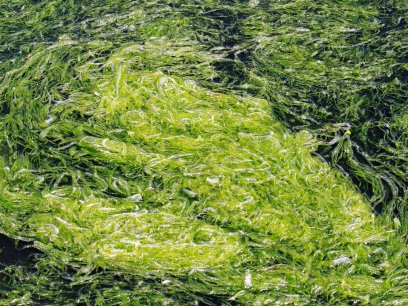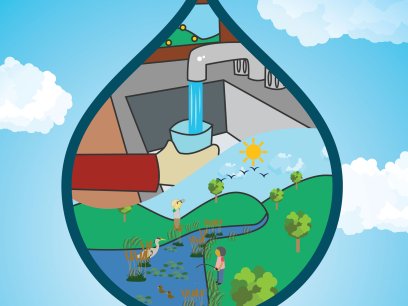
Revamping your outdoor space does more than just enhance your home's curb appeal or boost property value. It also offers a unique opportunity to positively impact local ecosystems and water quality and improve your quality of life.
While enhancing your home's exterior offers personal benefits, it also intersects with larger environmental challenges. One of the most significant is managing stormwater runoff—an issue that affects communities and ecosystems nationwide.
Understanding Stormwater Runoff
Individual landscaping decisions can play a crucial role in controlling some of our pervasive environmental concerns. Stormwater runoff occurs when water from precipitation rushes across impermeable surfaces such as paved streets, driveways, and rooftops instead of soaking into the ground.
These harmful pollutants flow into our rivers, streams, lakes, and coastal waters, negatively affecting these ecosystems. In some cities with combined sewer systems, stormwater and raw sewage are transported to wastewater facilities for treatment before being discharged. When the capacity of these combined sewer systems is exceeded, untreated sewage and stormwater flows directly into nearby waters, creating a toxic environment for fish, plants, and other aquatic species.
The Impact of Combined Sewer Systems
Approximately 700 US cities have combined sewer systems that overflow into nearby waterways during large storms. This translates to an estimated 10 trillion gallons of untreated water polluting our nation’s waterways each year. When you understand where our drinking water comes from and the work that goes into making it safe, it's easy to see how this problem can put pressure on the country’s already strained water resources.

Overflow from these sewage systems threatens public health and devastates local wildlife and habitats. Addressing this issue requires updated infrastructure along with community engagement in sustainable practices to reduce the burden on these overtaxed systems.
Stormwater Pollution and Infrastructure Solutions
As we consider the impact of sewage system overflows, it's important to recognize how stormwater contributes to water quality issues.
Stormwater pollution occurs when rainwater runs off hard surfaces like roads and rooftops, picking up pollutants and directing them, untreated, into our waterways. These pollutants range from road salt to fertilizers to heavy metals, which not only contaminate our rivers and oceans but also significantly affect local ecosystems.
Traditional gray infrastructure, including storm drains and concrete pipes, often fails to address these issues adequately. It does not improve water quality or reduce runoff volume.
Recognizing these limitations has led many communities to turn towards more holistic and sustainable approaches. By adopting new, greener solutions, cities can better manage stormwater, reduce reliance on outdated systems, and foster a healthier, more resilient urban environment.
These solutions not only manage stormwater more effectively but also enhance local environments and community spaces, providing a stark contrast to the limited functionality of traditional gray systems.
Embracing Green Infrastructure to Improve Water Quality
You can help restore the balance of natural water filtration through a cost-effective and sustainable approach to managing stormwater.
Green infrastructure encompasses projects that absorb rainwater, mitigate flooding, and help reduce pollution in local waterways. It supports water management by simulating natural water cycles. Using these strategies helps to capture and/or move precipitation away from buildings, relying less on built systems like sewers.

In addition to managing stormwater, green infrastructure projects can enhance urban aesthetics and increase green space, which can improve air quality and provide new habitats for wildlife. Cities can transform into more livable, breathable environments by integrating features like permeable pavements, green roofs, and enhanced tree canopies. These solutions prevent pollution and enhance urban aesthetics, improve air quality, and provide valuable habitats for urban wildlife.
Moreover, these projects often engage communities and promote stewardship of local natural resources. Implementing green infrastructure can serve as a catalyst for educational opportunities and community cohesion, making it a cornerstone for sustainable urban development. There are also positive health benefits from the time spent outdoors developing new green infrastructure.
Understanding Bioretention Systems
You can revolutionize your next landscaping project by harnessing natural processes to efficiently manage stormwater. Bioretention systems transform urban landscapes and help manage water from precipitation.
Bioretention involves techniques that manage stormwater by mimicking natural filtration. Systems such as rain gardens are designed to capture runoff from impervious surfaces like roofs and driveways.

Rain gardens filter this stormwater through layers of soil, sand, and gravel, cleaning it before it seeps back into the ground. This not only nourishes plants but also replenishes the local groundwater. By mimicking nature, bioretention helps reduce the impact on sewer systems downstream and decreases flood risks, making it a key strategy in urban water management.
Bioretention methods are flexible and applicable across diverse geographic locations in the country. They are integral for enhancing the sustainability of various landscaping projects. This adaptability makes them ideal for almost any landscaping design, significantly benefiting local ecosystems.
An essential aspect of bioretention is the strategic use of landscaping to maximize both functional and aesthetic values. Incorporating native plants that provide wildlife habitat can significantly improve the success of these systems.
These plants are chosen for their ability to thrive under the local hydrological conditions. Where possible, a mix of shrubs and herbaceous plants should be used, and trees can be integrated carefully, considering any surrounding infrastructure like power lines or underground pipes.
By implementing these innovative bioretention strategies, you can contribute directly to environmental protection right in your backyard and improve your health.
The Health Benefits of Green Spaces
Green spaces significantly enhance mental health. Studies have found that these natural settings reduce stress and improve mental wellness for people of all ages.
For example, tree canopies and parks are linked to stress relief, decreased crime rates, and reduced noise. A 2022 study found that engaging in physical activities in natural environments does more than just clear the lungs—it significantly enhances brain function.
Outdoor environments are particularly beneficial for children with ADHD, as nature can boost their concentration levels. Additionally, these settings help in managing emotions and reducing aggression. Veterans experiencing post-traumatic stress disorder (PTSD) can also find solace and recovery in the tranquility of nature, supporting their mental health journey as they transition back to civilian life.
These findings underscore the importance of incorporating green infrastructure in urban planning, ensuring communities have easy access to beneficial green spaces. The improvements you make—if approached thoughtfully—can help restore water quality and protect aquatic ecosystems.
How You Can Help: Implementing Green Solutions
As we explore the profound impact of our landscaping choices on water quality and the environment, it is essential to understand the problem and the solutions. Whether installing rain barrels, setting up rain gardens, or opting for permeable pavements, each action contributes to a larger effort to manage stormwater sustainably.
Let's explore how you can implement these practical strategies for your home and community.
Home Strategies for Reducing Runoff
Discover practical ways to manage and reduce stormwater runoff right at home, whether you have a large yard or a small outdoor space.
- Use a rain barrel to capture water from your roof. Then, reuse that water to irrigate your garden or refill a bird bath. Note: Some states prohibit the collection of rainwater, while others offer incentives for installing rain barrels. Check with your state and local water resource or environmental agency for details before purchasing or building one.
- Build rain gardens in your yard—shallow, planted basins that collect and absorb stormwater runoff from rooftops, sidewalks, and streets.
- Plant trees preserve existing ones. Trees decrease and slow runoff by providing a tree canopy of leaves and branches. This helps to reduce erosion—a major contributor to pollutants carried by stormwater.
- Install permeable pavement on driveways and walkways to allow water to infiltrate the ground.
- Point downspouts onto grass or gravel rather than paved surfaces to reduce the amount of polluted water that runs off your property.
Minimizing Stormwater Pollution
Learn how to reduce your contribution to stormwater pollution with everyday actions.
- Always dispose of litter properly and never use storm drains or water bodies as dumping grounds. Engage in recycling and trash removal from outdoor areas.
- Clean up after pets and keep them away from streams and rivers to lower the risk of bacterial and nutrient pollution.
- Adhere to guidelines for lawn chemicals and use fertilizers and pesticides sparingly. Instead, opt for eco-friendly options like those listed in the EPA's Safer Choice Program.
- Be mindful of the weather; avoid applying chemicals to inactive lawns or before rainstorms to prevent runoff.
Community Solutions to Control Stormwater
Explore community-level strategies that utilize both modern and natural methods to manage stormwater effectively. Keep in mind that the most effective stormwater pollution prevention plans employ multiple strategies.
- Low-impact development (LID) and green infrastructure practices utilize natural landscapes to manage stormwater by slowing, detaining, or filtering pollutants, effectively reducing runoff contamination.
- Green Infrastructure Modeling Toolkit: The EPA offers models and tools that can help communities effectively manage water runoff using sustainable practices that combine green and gray infrastructure. This approach enhances resilience and sustainability in urban and other environments.
- Educational outreach to homeowners and businesses about the proper handling and storage of hazardous materials, equipment upkeep, and responsible landscaping practices play an important role in preventing environmental pollution.
- Preserving or utilizing natural landscapes like green roofs, forested areas, and grass waterways effectively slows down, detains, or filters out contaminants from stormwater through natural processes.
- Erosion and sediment control measures are crucial for preventing sediment, chemicals, and nutrients from being carried away from construction sites into the environment.


